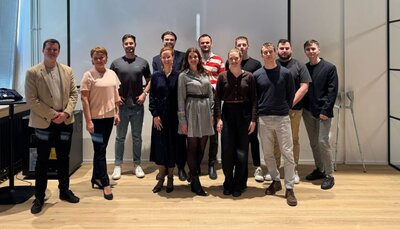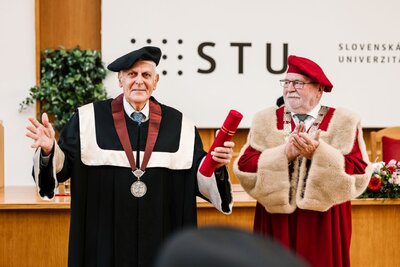Slovak University of Technology in Bratislava in brief
Slovak University of Technology in Bratislava (hereinafter referred to as "STU") is a modern educational and scientific institution. Since its foundation in the year 1937 more than 159.000 students have graduated. In average, 12.000 students study at the STU every year.
At present, the STU consists of seven faculties based in Bratislava and Trnava. All the faculties provide a study in accredited study programmes within the complex system of a bachelor, master and PhD. study. Faculties realise credit system compatible with the European credit transfer system enabling mutual mobility of students within European Union member countries and a larger European space. In the area of scientific and research activities the STU successfully joins European Union programmes.
STU is a public university and offers education mainly in technical, technological, technical-economical, technical-information and technical-artistic fields of study using the modern methods of education, laboratories and practical training. It is aimed at the study branches with stable opportunities of students' employment at the labour market.
Complex accreditation of the operation of STU has been completed in 2009. Based on the declaration of the Accreditation Commission, the counselling body of the Government of the Slovak Republic, STU continues to be classified as a university-type college. According to Article 84, Section 5 of Act No. 131/2002 Coll. on universities, on amendments and supplements to certain laws as amended and upon the declaration of the Accreditation Commission, the Minister of Education of the Slovak Republic has conferred a right to STU to grant relevant academic titles to graduates of study programmes in study branches.
The studies at STU and its faculties are performed at 3 levels:
1. the bachelor degree study programme
2. the engineer or master degree study programme
3. the doctorate degree study programme
STU offers education in foreign languages, primarily in the following areas: civil engineering, mechanical engineering, electrical engineering, chemistry and food technology, architecture.
International cooperation is a significant area based on interactive contact with educational as well as scientific-research institutions of the countries all over the world. First of all, it is focused on solution of the joint projects within the EU framework and other international programmes, mobility of students, teaching staff and researchers.
STU system of education is connected with the prestigious partner universities in the framework of international programmes, especially Erasmus+.
Today, one of the main tasks of STU is the active policy in the area of foreign students' recruitment. The number of foreign students at individual STU faculties has been raised several times during the past years. STU creates for the students high-quality conditions for the study and for active use of free time.
STU also fulfils its mission in the field of further education, by means of the preparation, organization and assuring of further education, which is prepared at the particular faculties of the university and by the Institute of Life-Long Education of STU.
The Study and Information Centres (libraries) are parts of the faculties of STU and by means of the special and scientific book stock, the information, bibliographic and documentary activity, these centres can create for the students and university employees good conditions for successful studies and scientific work. Apart from the faculty libraries, students can study in other libraries of Bratislava and Trnava.
Accommodation and catering of the students are assured by the Student houses and Canteens.
The doctors in the Youth and Dental Clinics take care of the student's health.
The students and university employees have at their disposal sports facilities - playing grounds, gymnasiums, swimming pools, tennis-courts, fitness centres etc.
The University has its own university artistic ensemble Technik which has 3 parts: a chamber orchestra, a choir and a folklore dance group. The members of the ensemble are mostly the students of the university.
STU was the first university in the Slovak Republic, where a Careers Advisory Centre (CKP) was created as a part of the Department of Education and Student Care by a decree of the STU Management Board in 2005.
Mission of the CKP is mainly to provide information of job vacancies, part-time jobs and student-oriented products; to mediate contacts between students, future university graduates and employers; to monitor the requirements of the jobs market in order to better adapt the preparation of students to the requirements of employers during the recruitment process; to organise work meetings between the representatives of institutions and companies and students and relevant university staff; to organise presentation meetings and discussion forums with institution representatives and students; to carry out a controlled promotion of professional demand on the university web page and via informational and promotional materials.
Structure of the University
Faculties
Faculty of Civil Engineering
Faculty of Mechanical Engineering
Faculty of Electrical Engineering and Information Technology
Faculty of Chemical and Food Technology
Faculty of Architecture
Faculty of Materials Science and Technology
Faculty of Informatics and Information Technologies
University Institutes
Institute of Management
University workplaces
Archive
Institute of Life-Long Education
Computing Centre
Publishing House
Research Centre
Special-purpose facilities
University Artistic Ensemble Technik
Student Houses and Canteens
Study and Training House in Gabčíkovo
History of the University
The history of the higher technical education in Slovakia has started in the year 1762 by the foundation of the Academy of Mining and Forestry in Banská Štiavnica by Maria Theresa. The establishment of the Academy of Mining and Forestry was important moment in the history of higher technical education, as it was the first educational institution in Slovakia providing technical education at the university level. The Academy of Mining and Forestry has maintained its high level of standard for more than 150 years of its existence and has founded the tradition of excellence of higher technical education in Slovakia.
More than two decades of struggles preceded the establishment and enactment of the first university in Slovakia. The Technical University of M. R. Štefánik was founded in Košice and authorised by the Act No. 170/1937 Coll. of the Czechoslovak National Council, on June 25, 1937.
The Technical University of M. R. Štefánik consisted of three sections:
1. Section of Construction and Transportation Engineering
2. Section of Hydraulic and Cultural Engineering
3. Section of Land Surveying Engineering
The very first academic year was opened on the December 5, 1938 at the temporary seat situated in the town of Martin, where the Technical University of M. R. Štefánik was moved swiftly very short after the Munich Treaty and Vienna Verdict, when southern regions of Slovakia, including the town of Košice, were annexed to Hungary.
In February 1939 the Technical University of M.R. Štefánik has been renamed to the Slovak Technical University (SVŠT) and it has been moved to its present seat - to Bratislava. At the same time the Act No. 188 Coll. issued on July 25, 1939 has laid the legal basis for its full development. The Slovak Technical University (SVŠT - Slovenská Vysoká Škola Technická) has been expanded - three new sections were founded, twelve new institutes were established and all sections were renamed to branches:
1. Branch of Construction Engineering
2. Branch of Specialised Sciences
3. Branch of Forestry and Agricultural Engineering
4. Branch of Chemical Engineering
5. Branch of Mechanical and Electrical Engineering
6. Branch of Economic Engineering
Among the founders and the most outstanding personalities of the Slovak Technical University (SVŠT - Slovenská Vysoká Škola Technická) belong such outstanding personalities as professors: Juraj Hronec (the first Rector), Karel Krivanec, Jozef Kaucky, Karel Havelka, Dimitrij Andrusov, Peter Danisovic, Emil Bellus, Dionyz Ilkovic, Frantisek, Valentin, Mikulas Gregor, Juraj Gasperik, Frantisek Kozmal, Jozef Cabelka, Jan Gonda, Ľudovit Kneppo, Štefan Schwarz and many others who were building up the university in the harmony with other European technical universities.
The Slovak Technical University (SVŠT - Slovenská Vysoká Škola Technická) has laid the background not only for the classical technical branches and architecture but also for natural sciences, forestry, agriculture, mining and arts, which have been in a run of time separated into independent universities.
The Slovak National Council Decree issued on the April 25, 1946 has waived The Branch of Forestry and Agricultural Engineering and at the same time gave the origin to the foundation of the independent University of Forestry and Agricultural Engineering established in Košice where it operated until it has been separated in the year 1952. In the academic year 1946/1947 the Institute of Architecture and Civil Engineering was established at the Branch of Civil Engineering. In September 1947 the Institute of Drawing and Painting, specialised to educate future secondary school teachers, was transferred to the Faculty of Pedagogy of the Slovak University (previous name of the Comenius University in Bratislava).
Higher education Act No. 58/1950 Coll. issued on May 18, 1950 has initiated substantial changes which have influenced all areas of higher education - organisational and managerial structure, educational, scientific and research system. The Act No. 58/1950 Coll. defined that faculty is the basic body of higher education institutions. The Slovak Technical University branches were consequentially renamed to faculties and since the academic year 1950/1951 there were the following faculties:
|
1. Faculty of Construction Engineering |
During the '50s there were realised also other changes at the Slovak Technical University (SVŠT - Slovenská Vysoká Škola Technická). The Faculty of Mechanical and Electrical Engineering has been separated into two independent faculties: the Faculty of Mechanical Engineering and the Faculty of Electrical Engineering.
Faculty of Specialised Sciences ceased to exist and its first institute "the Institute of Mining" gave origin to the foundation of the new Faculty of Mining Engineering which was established in the academic year 1951/1952, its second institute "the Institute of Land Surveying" was transferred and incorporated into the Faculty of Construction Engineering.
The Faculty of Mining Engineering has been separated from the Slovak Technical University (SVŠT - Slovenská Vysoká Škola Technická) in the academic year 1952/1953 and incorporated as a part of the new Technical University in Košice.
The Faculty of Economic Engineering with three institutes - Chemistry, Civil and Mechanical Engineering - was also established in the academic year 1951/1952. However, this faculty ceased to exist in the year 1960 and its institutes were transferred and incorporated into the appropriate faculties.
In the year 1960 also the Faculty of Construction Engineering and the Faculty of Architecture and Construction Engineering were fused into a single one under the new name the Faculty of Civil Engineering.
In the year 1965 the Faculty of Chemical Engineering was renamed to the Faculty of Chemical Technology.
In the year 1976, Architecture studies were separated from the Faculty of Civil Engineering and gave the origin to the foundation of the new Faculty of Architecture.
On January 1, 1986 the Faculty of Machine Technology was established in the town of Trnava (50 km from Bratislava) and in the year 1991 this faculty was renamed to the Faculty of Materials Science and Technology.
On January 1, 1993 the new Faculty of Specialised Studies was founded in Trnava and after two years of its existence it ceased to exist in the year 1995.
In the harmony with the Slovak National Council Act the Slovak Technical University (SVŠT - Slovenská Vysoká Škola Technická) was renamed to the Slovak University of Technology in Bratislava (Slovenská technická univerzita v Bratislave) on April 1, 1991.
On July 1, 2001 the Faculty of Chemical Technology was renamed to the Faculty of Chemical and Food Technology.
On October 1, 2003 the Faculty of Informatic and Information Technologies was established.
At present the Slovak University of Technology in Bratislava consists of the 7 faculties.



